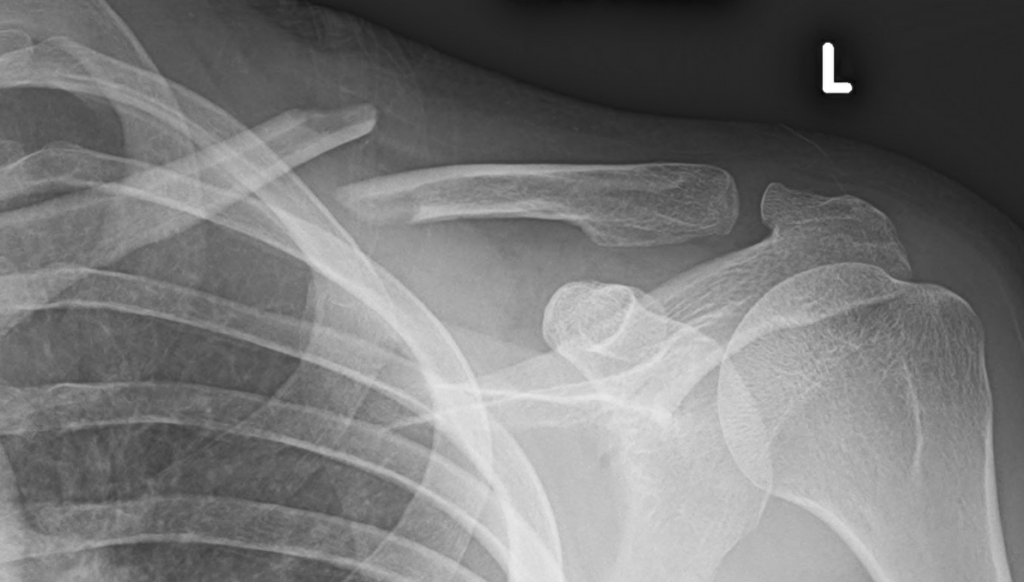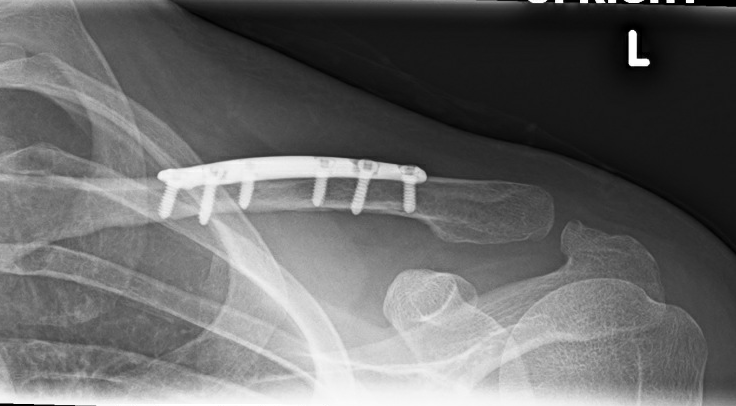Surgery for Broken Bones of the Collar Bone/Clavicle
Your Diagnosis
Surgery to repair a broken collar bone is done to help straighten the bone properly so it heals in the correct position. Another term for repairing a broken bone is an “open reduction and internal fixation”, or ORIF. See Broken collar bone/broken clavicle section. If surgery is not performed, the bone will usually still heal on its own, however, it is often not in the correct position. This can decrease the person’s chance of having good range-of-motion and good function.
What happens during Surgery?
Surgery takes between 30 and 45 minutes. It is done with general anesthesia, meaning the person is asleep. An incision is made directly over the broken portion of the collar bone. The bone is pushed into normal alignment and then a plate and screws are place on the bone to hold it in place (see picture).
Immediately after Surgery
The
person will wake from surgery in the recovery room where they will spend 1
to 3 hours. Most people will then be
allowed to go home when they are awake enough. The person will go home in a
sling. The person cannot drive or take public transportation home. They must
have a ride.
The person may notice numbness of the chest below the incision. This is because the tiny skin nerves were cut when making the incision. This is normal. The numbness usually goes away over the next 6 to 12 months.
A person may have questions following your surgery. Many of these frequently asked questions about surgery can be answered here.
What to expect after Surgery: week 0 through week 6 (Phase One)
- Pain: Immediately after surgery the person usually has a moderate amount of pain. The pain level is about the same as when it just broke. This is treated with oral pain medications. Usually the pain level drops quickly since the broken bone ends are no longer able to rub and grind against themselves.
- Therapy: The bones will require about 6 weeks to heal. Usually no formal therapy is needed for the first 6 weeks. During this time it is important to take it easy with the arm. The person can and should continue to move their arm and shoulder to help prevent the shoulder from stiffening up.
- Precautions: The person should rest the shoulder and take it easy. The person should refrain from sports, lifting anything heavier than half a pound, or bearing weight. They should also avoid any activities that could result in trauma or re-injury. The only form of exercise a person should do at this point, is:
- walk uphill on a paved, even road with their arm in a sling or relaxed at their side OR
- ride a stationary bike with their arm in a sling or relaxed at their side
- Work: Most people take several days to a week off from work to recover. If a person has a physically demanding job, they will probably have to take off longer.
What to expect after Surgery: week 6 through week 12 (Phase Two)
- Pain: Most people will have little to no pain on their collarbone after 6 weeks. Some people will have shoulder stiffness, because they have not moved their shoulder “normally” for 6 weeks. A person may have discomfort over their surgery site when they wear a backpack or bag. It is important to realize that at the 6 week mark, every person is expected to be weak.
- Therapy: It is common that after 6 weeks of “taking it easy” a person may have stiffness or tightness and weakness in the shoulder. If this the case, a person may be referred to do therapy, where they can learn stretches to help with the stiffness. At this point, the person will also begin a light weight, high repetition exercise program. The person should avoid any sort of activity that could cause another trauma for another 6 weeks.
- Precautions: When the doctor has determined that the bone has healed a person’s restrictions will be lifted. In other words, a person may begin activity as guided by “pain and common sense”. If it hurts a little when doing a certain activity, a person may continue doing the activity. If it hurts too much, that’s the body’s way of saying that the person needs to slow down and back off whatever activity they were just attempting. A person should begin activities cautiously and using “common sense”. For example, if a person wants to try to go swimming, they should try it from the shallow end of a pool (they should not jump into the ocean when the surf is big and the current is strong).
- Work: Most people who have jobs that require physical labor are not ready to return to work at the 6 week mark. Some may be ready to go back around week 8-10. It’s unlikely that a person who has a highly physical job will go back to full duty at this time.
What to expect after Surgery: week 12 through 1 year and beyond (Phase Three)
- Pain: Most people have no pain. The person may have discomfort and irritation with pressure over the scar.
- Therapy: At the 12 week mark, it is likely that the person will feel flexible and strong.
- Precautions: If a person is as flexible and as strong as they were prior to their injury, then all restrictions may be lifted and the person may resume contact sports.
- Work: Most people have returned to work.
Removing the Metal Hardware (the plate and screws)
For many people the plate and screws will continue to bother them either because of pain when pressure is put over the plate or because the plate is visible under the skin. Others just don’t want to go through life with a metal plate and screws if it is not needed. For these reasons, many people want the plate and screws to be removed once the bone has healed. The plate and screws can be removed any time after 3 month after surgery if the bone has healed (see picture).
In order to remove the plate the person must have another surgery. During this surgery the person will be asleep and the original wound will be re-opened. The plate is then removed and the bone is smoothed. The surgery usually takes 15 minutes.
After the surgery the person can use their arm right away. They must be aware that right after surgery the bone without the plate is weaker than it was with the plate. Over time the bone strengthens back to normal. While it is strengthening the person should avoid activities that could break the bone such as skateboarding, skiing, wrestling, etc.

Broken collar bone/clavicle

Fixed collar bone/clavicle
